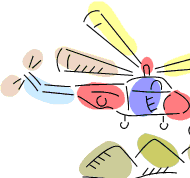The Unexpected
in ASRS Reporting
October, the eighth month in the old Roman calendar (“octo” means eight), is the official month for National Popcorn Poppin’, Canadian Thanksgiving, Columbus Day, and Halloween, to mention just a few of the events celebrated in this month. This harbinger of autumn, pumpkin festivals, and trick-or-treating also seems an appropriate month in which to share Unexpected Events reported to the ASRS. If these events have anything in common, it’s that the unexpected should be anticipated in aviation activities.
“It Soon Got Very Dark and Quiet”
Shortly after landing, a B777 had to apply heavy braking to avoid overtaking a slower aircraft during taxi to the gate. After this conflict, the Boeing Captain stated to the First Officer that they should “probably shut one down” [to avoid repeated braking for the slower aircraft]. The First Officer’s report tells what happened next:
-
…I looked over and noticed he was guarding the left fuel control so I shut the right engine down. To our dismay, it soon got very dark and quiet and we realized we had both shut an engine down. The Captain braked the aircraft to a stop. I cranked the APU, remained seated, notified Tower we would be holding for a few minutes and waited forever for the minute to pass and enjoy the resumption of electrical power. I then started both engines. We resumed taxi to the gate. The outcome was a 4-minute delay in taxiing to the gate at the end of an otherwise very normal flight. No doubt stressful for the crew and passengers. From a human factors point of view…I feel that fatigue and jet lag played an important role on this evening…flipping one’s body clock by 12 hours in a 24-hour period has its challenges. It is still a 2-pilot operation in the dark on the backside of the body clock….
The Captain’s report of this same incident added that there was “too much verbalization” in the cockpit and “not enough commands.”
“A Cigarette Boat…Was Upon Us”
An instructor pilot and student aboard a float-equipped PA18 became airborne prematurely when they encountered unexpected high-speed boat traffic on a river.
 We had just departed the sea plane base and back ‘water’ taxied approximately 500-600 yards down river towards downtown in order to have plenty of room to execute a normal water takeoff up river and into the wind. It was a beautiful day and there was moderate boat traffic on the river.We cleared the area around and behind us, completed our takeoff checklist, and executed a turn into the wind and up river. It seemed that as we maneuvered into position and after we turned all of our lights on, that all the boats in the general area pretty much motored towards the sides of the river. We began our takeoff run and for a split second our nose was high as we were coming onto our ‘step.’ Once the nose of the aircraft leveled out, we accelerated relatively quickly. As we were nearing flying speed a cigarette boat, traveling at a very high rate of speed, came around the corner under the bridge and was upon us. I believe the boat operator noticed us just in time, but because of the speed he was carrying, he could only alter his course slightly. However, in doing so, he cut right in front of us. We were traveling too fast to chop the throttle and maneuver[so] as not to create a hazard to the other boat operators or ourselves, yet too slow to fly. When we hit his wake, we became airborne. We grabbed a hand full of flaps so [as] not to slam back into the water. Once in ground effect, we accelerated to a speed…too slow to climb above the bridge beginning to fill our windscreen. We were left with only one safe option…Fly under the bridge. We were approximately 5-10 feet above the water, 40-50 feet under the bridge. When we cleared the bridge it was…an uneventful climb to 1,500 feet heading up river. That was without a doubt too close for comfort…I believe we made the safest decision for the situation which dictated split-second thinking. We had just departed the sea plane base and back ‘water’ taxied approximately 500-600 yards down river towards downtown in order to have plenty of room to execute a normal water takeoff up river and into the wind. It was a beautiful day and there was moderate boat traffic on the river.We cleared the area around and behind us, completed our takeoff checklist, and executed a turn into the wind and up river. It seemed that as we maneuvered into position and after we turned all of our lights on, that all the boats in the general area pretty much motored towards the sides of the river. We began our takeoff run and for a split second our nose was high as we were coming onto our ‘step.’ Once the nose of the aircraft leveled out, we accelerated relatively quickly. As we were nearing flying speed a cigarette boat, traveling at a very high rate of speed, came around the corner under the bridge and was upon us. I believe the boat operator noticed us just in time, but because of the speed he was carrying, he could only alter his course slightly. However, in doing so, he cut right in front of us. We were traveling too fast to chop the throttle and maneuver[so] as not to create a hazard to the other boat operators or ourselves, yet too slow to fly. When we hit his wake, we became airborne. We grabbed a hand full of flaps so [as] not to slam back into the water. Once in ground effect, we accelerated to a speed…too slow to climb above the bridge beginning to fill our windscreen. We were left with only one safe option…Fly under the bridge. We were approximately 5-10 feet above the water, 40-50 feet under the bridge. When we cleared the bridge it was…an uneventful climb to 1,500 feet heading up river. That was without a doubt too close for comfort…I believe we made the safest decision for the situation which dictated split-second thinking.
The One That Got Away (Thankfully!)
A Robinson R44 helicopter became the unintended prey of a surf fisherman along the coastline.
- I was traveling over the water along the coastline at about 115 knots. A man with a large surf fishing rod cast his lure out to sea and hit the helicopter, breaking the pilot side
 Plexiglas window and [causing] cosmetic damage to the mast fairing. No one was injured, no loss of controls, so I proceeded back to the airport. Plexiglas window and [causing] cosmetic damage to the mast fairing. No one was injured, no loss of controls, so I proceeded back to the airport.
Side Window Smack-Down
The Captain of a B737-800 encountered a crushing surprise when trying to talk out of the cockpit’s sliding side window.
-
We were at the gate for a flight. The jetway was pulled away from the plane in preparation for pushback. I needed to talk to the gate agent so I unlocked the #2 sliding window and pulled back the handle. The window opened 3 inches, then the entire window (frame, glass, and connections) fell out and pinned me into my seat. The top of the window hit my shoulder very hard, and the bottom hit my leg with the aft portion resting on my book bag. The window was very heavy and the First Officer and I could not move it. I eventually managed to push it off my leg and rest it on the seat. The First Officer held the top while I slid out of the seat. I banged my knee on the window while getting out. I badly bruised my shoulder and leg. The device missed my face by inches. The mechanic told me that the window weighs 80 pounds. Maintenance was called, and they put the window back into the track….
The reporter offered no explanation of how the window came to be loose in its tracks.
Keystone Capers
A PA22 pilot’s “go-fly-itis” resulted in an aircraft landing that recalls the Keystone Capers—leaping into the air, veering in all directions, and a final pratfall. But this was no comedy maneuver.
-
…The PA22 has a demonstrated 14 mph crosswind landing limit. After departure, the Tower was reporting winds at 260-280 degrees at 18 knots, gusting to 24 knots. Upon approaching to land on Runway 18L, one notch (20 degrees) of flaps was selected and an approach speed of 70 mph was used. Full right crosswind control inputs were applied (full right aileron and 75% left rudder). Aircraft touched down on centerline, right wing low, and was maintaining track with left wheel still off the ground. Brakes were applied to slow aircraft. Aircraft has ‘Johnson bar’ single brake lever that actuates both brakes at once. Upon application of brakes, aircraft slowed and tracked straight until left wheel contacted runway. Left wheel locked up and skidded, causing aircraft to pirouette to the left. Once aircraft pirouetted to the left, crosswind continued to push aircraft towards the left side of the runway. Aircraft departed runway into grass. A 10-foot deep ditch was 100 feet to the left side of the runway. Upon seeing that aircraft would likely skid into the ditch, full power was applied. Aircraft was configured for short field takeoff and accelerated in ground effect, skipped across the ground and ditch, impacting on the far side. Impact caused the aircraft to become airborne. Aircraft slowly gained altitude, avoiding chain link fence, shipping containers and light poles by about 10 feet. Aircraft was allowed to accelerate and climb away. Pilot notified Tower that he was back in control of the aircraft, landing on the east/west Taxiway J at the airport. Tower requested a simulated approach to see if the aircraft could safely make approach. Emergency equipment was positioned next to Taxiway J. Pilot landed aircraft on Runway 18L crossways and taxied onto Taxiway J to full stop. Winds at the time of landing were 280 degrees at 20 knots…Wind conditions exceeded the demonstrated crosswind landing capabilities of the aircraft and pilot.
An Understandable Altitude Excursion
From a General Aviation pilot’s report to ASRS:
- I was assigned a block altitude from 17,000 feet to 19,000 feet. I had started by climb up to 19,000 feet when I hit severe turbulence. I was knocked unconscious and didn’t recover until 15,000 feet. The turbulence smoothed out after that, and I landed….
Cell Phone Commotion
The pilot of a vintage J-3 Cub floatplane reported to ASRS that a cell phone call from a misguided golfer set in motion a law enforcement and search and rescue effort.
- I aborted a landing on the southwest end of ABC Lake due to low level turbulence, windshear, and lake obstructions. At this time, I commenced on my route of flight southward over the golf course. According to [sheriff]…during climbout/departure of the aborted landing and passage of the golf course, a golfer called emergency personnel stating that a yellow aircraft flew over the golf course with wings rocking and engine sputtering. The individual then apparently stated he believed the aircraft crashed…[Another individual], after hearing the…commotion on her scanner, witnessed a yellow floatplane land on XYZ Lake. She stated the pilot stopped to fix the propeller, and minutes later took off heading southbound.
In reality, I attempted to land in ABC Lake to relieve myself, but due to weather constraints and other parameters could not do so safely, thus aborting the landing and continuing southbound. Due to moderate turbulence, windshear and closely spaced isobars the wings were rocking the entire route of flight…I could safely maneuver my aircraft for landing at XYZ Lake…The airplane…does not have an electrical system, therefore it needs to be started by hand. This is what I was doing: starting my airplane…[not] “fixing the propeller.” I continued on my way home, arrived safely, tied my floatplane to the dock, just as I do every time.
I never broke any FARs and operated my aircraft in a safe and responsible manner and had no mechanical issues with the airplane I was piloting. Unfortunately, a golfer with a cell phone…was the catalyst for the much wasted time of private search personnel, law enforcement officers, and many search and rescue airplanes being deployed.
|




 Plexiglas window and [causing] cosmetic damage to the mast fairing. No one was injured, no loss of controls, so I proceeded back to the airport.
Plexiglas window and [causing] cosmetic damage to the mast fairing. No one was injured, no loss of controls, so I proceeded back to the airport.